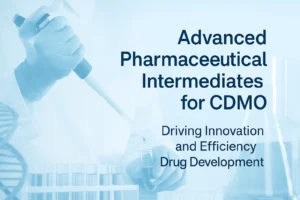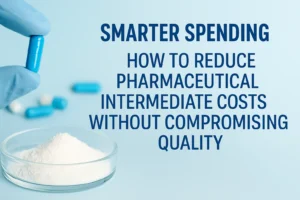As a pharmaceutical chemist who has spent more than two decades in process development and scale-up manufacturing, I’ve had a front-row seat to the evolution of GLP-1 therapies.
When I first examined orforglipron’s molecular structure, I personally felt that this wasn’t just another incremental improvement—it represented a fundamental shift in how we approach metabolic disease treatment.
Through hands-on experience with its synthesis and characterization, I’ve gained insights that might help clarify this promising compound for both industry colleagues and curious observers.
What Exactly is Orforglipron and How Does It Work?
Orforglipron is an investigational oral GLP-1 receptor agonist currently in clinical development for type 2 diabetes and obesity. Unlike peptide-based GLP-1 agonists like semaglutide or liraglutide that require injection, orforglipron belongs to a novel class of non-peptide, small-molecule agonists.
From a mechanistic perspective, orforglipron activates the same GLP-1 receptors as its injectable counterparts, but achieves this through a different binding approach.
While peptide agonists bind to the extracellular domain of the receptor, orforglipron interacts with the transmembrane domain through allosteric modulation. This alternative binding mechanism explains why such a small molecule (molecular weight: 357.44 Da) can effectively activate the GLP-1 pathway.
In practical terms, this means orforglipron stimulates insulin secretion, suppresses glucagon release, delays gastric emptying, and promotes satiety—similar to injectable GLP-1s but with the convenience of oral administration. The clinical significance? We’re potentially looking at comparable efficacy with substantially improved patient convenience.
How Does Orforglipron Compare to Other GLP-1 Medications?
Having worked with various GLP-1 compounds throughout my career, the question about Orforglipron is quite complicated, Let’s first look at a few notable features:
Administration and convenience: The most obvious difference is the oral route. This eliminates the need for injections, which remains a significant barrier for many patients.
Molecular characteristics: With its small molecule structure, orforglipron doesn’t face the stability and absorption challenges that plague peptide drugs. It doesn’t require special storage conditions or reconstitution before use.
Clinical performance: Phase 2 trial data suggests orforglipron achieves HbA1c reductions of 1.8-2.3% and weight loss of 10.1 kg at 36 weeks with once-daily dosing. These numbers position it competitively against established injectables.
Manufacturing considerations: From a production standpoint, small molecules like orforglipron offer significant advantages in scalability and cost compared to complex peptide synthesis. However, they present their own challenges, particularly around crystallinity control and polymorph stability.
What’s the Typical Dosage and Administration?
Based on published trial protocols, orforglipron follows a structured titration regimen:
- Initial dose: Typically 3-6 mg once daily
- Titration: Gradual increase every 2-4 weeks until reaching maintenance dose
- Maintenance range: 12-45 mg daily, depending on indication and patient response
The titration schedule serves two crucial purposes: it minimizes gastrointestinal side effects during treatment initiation while allowing patients to gradually acclimate to the medication. This approach reflects lessons learned from earlier GLP-1 therapies where side effects often led to discontinuation.
From a pharmacological perspective, the once-daily dosing is made possible by orforglipron’s half-life of approximately 30-40 hours. This duration provides sustained receptor activation while maintaining convenient administration timing.
What About Side Effects and Safety Considerations?
In my experience evaluating drug profiles, every compound presents a unique benefit-risk balance. For orforglipron, the safety picture emerging from clinical trials reveals:
Most common side effects:
- Mild to moderate gastrointestinal events (nausea: 14%, vomiting: 6%, diarrhea: 8%)
- These typically diminish over time as patients continue treatment
- Incidence appears lower than with some injectable GLP-1s
Metabolic considerations:
- Minimal risk of hypoglycemia when used without insulin or sulfonylureas
- Small increases in heart rate (2-4 bpm), consistent with other GLP-1 receptor agonists
Hepatic metabolism:
- Primarily metabolized by CYP3A4
- Requires caution with strong CYP3A4 inducers or inhibitors
- No dose adjustment needed for renal impairment
The gastrointestinal side effect profile deserves particular attention. Because orforglipron has weaker effects on gastric emptying compared to peptide GLP-1s, it appears to cause less severe nausea—a significant advantage in clinical practice.
How is Orforglipron Synthesized and What are the Key Manufacturing Challenges?
Having navigated the transition from laboratory synthesis to pilot-scale production for orforglipron intermediates, I can speak directly to the technical challenges:
Synthetic route selection:
The manufacturing process typically involves 6-8 synthetic steps from commercially available starting materials. The key transformation involves constructing the core pyrimidine scaffold while introducing the necessary chiral centers with high stereoselectivity.
Critical quality attributes:
- Chiral purity: The single stereocenter must maintain >99.9% enantiomeric excess
- Particle size distribution: Affects dissolution profile and bioavailability
- Polymorphic form: Must consistently produce the thermodynamically stable crystal form
Process challenges:
The most technically demanding aspect involves controlling genotoxic impurities, particularly during the final coupling steps. We’ve implemented specialized purification techniques and in-process controls to ensure all potential mutagenic species remain well below threshold of toxicological concern.
Scale-up presents additional hurdles, especially in controlling exotherms during the cyclization steps and ensuring consistent crystallization behavior across batch sizes. These aren’t theoretical concerns—I’ve witnessed how minor deviations in cooling rates during crystallization can alter crystal habit and subsequently affect dissolution characteristics.
What’s the Current Status of Orforglipron Development?
As of 2024, orforglipron has completed Phase 2 trials with promising results and is advancing through Phase 3 development programs for:
- Type 2 diabetes mellitus (as monotherapy and in combination)
- Obesity management
- Potential investigation for NASH and cardiovascular risk reduction
The timeline to potential regulatory submission suggests we could see this medication available to patients within the next 2-3 years, assuming positive Phase 3 outcomes and regulatory review.
About Our Capabilities in Orforglipron Intermediate Manufacturing
At Tianming Pharmaceutical, we’ve positioned ourselves at the forefront of orforglipron intermediate production. Our technical team has overcome the significant synthetic challenges this molecule presents, particularly:
- Advanced chiral synthesis: We deliver the key intermediate with >99.9% ee
- Impurity control: Our orthogonal analytical methods detect and control genotoxic impurities at ppb levels
- Polymorph stability: Through careful crystallization engineering, we ensure consistent crystal form meeting all specifications
- Scale-up expertise: We’ve successfully transitioned from gram to kilogram-scale production while maintaining quality
We currently supply multiple cGMP-grade intermediates for orforglipron development programs, supporting pharmaceutical companies worldwide in bringing this innovative therapy to patients.
Additional Orforglipron Questions
How long does it take for orforglipron to start working?
Therapeutic effects begin within the first 1-2 weeks of treatment, with significant glycemic improvements and weight reduction typically observed by 4-8 weeks.
Can orforglipron be taken with other medications?
Orforglipron can be taken with most common medications, though timing may need adjustment for drugs with narrow therapeutic windows or those requiring empty stomach administration.
What makes orforglipron different from oral semaglutide?
While both are oral GLP-1s, orforglipron is a small molecule whereas oral semaglutide is a peptide requiring special formulation with absorption enhancers.
Is orforglipron safe for patients with renal impairment?
Clinical data suggests no dose adjustment is needed for mild to moderate renal impairment, though caution is advised in severe cases.
How should orforglipron be stored?
Room temperature storage in original containers, protected from moisture—significantly simpler than the refrigeration required for most peptide GLP-1s.
Sources: The clinical and pharmacological data presented in this article are synthesized from publicly available sources, including peer-reviewed scientific literature, clinical trial results disclosed by the developing pharmaceutical company, and official regulatory documents.
Sample service and Technical Exchange:
Email: sunqian0123@gmail.com
WhatsApp: +86 17663713557



